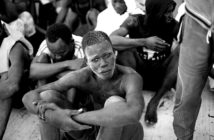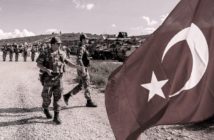We heard a lot about the participation of sectarian militias from several regional countries in Syrian civil war. Beginning with the Lebanese Hezbollah, who recently admitted their participation in the Syrian war publicly, continuing with the militia of the Iraqi Abu al-Fadl al-Abbas brigade and last but not least, the news of frequent participation of Iranian military forces in the war alongside the al-Assad regime…
On the al-Ramouseh front, one of the fronts raging in Aleppo city,witnesses describe fierce battles between rebels and regime forces over the past two months. The rebels noticed that some units fighting against them were useda foreign language and after hacking into the communication frequencies, it appeared to be a Persian language.
Not far away, and whilst the clashes are constantly taking place, fighters from the Abu Amara brigade snuck out to one of the points intended to be a regime sniper position and managed to take out the sniper, that was weakening the rebels’ positions.
The rebels were surprised by the fact, that the man did not seem Syrian, but also because the sniper weapon that was used was not, nor were the bands which were on the fighter’s wrists and forehead. Those bands contained phrases, which bore sectarian writing.
Beyond that, the documents, photographs and videos onhis mobile phone were mostly ofbattlefields and other urban areas, but the people in them were not Arabs.
The Abu Amara brigade said in a broadcasted report that the sniper did not have any documents proving his identity. They only found three memory sticks in his possession, showing his journey across Lebanon with his colleagues with Asian features.
The memory sticks contained thousands of images and video-clips that show the fighter and his colleagues in Lattakia (Syria) and the mountains. Additionally, it shows Shi’a shrines in Syria andin Lebanon.
In most of the pictures they appear wearing military uniforms with bands bearing sectarian phrases indicating affiliation of some of them to the Iraqi Abou el-Fadl Abbas brigade.
The video clips also contained recordings of fighters who spoke Persian language during battles on many fronts, including the countryside of Lattakia, and an interview with one of them, talking about the development of one of the fronts and the reasons that led him to fight. Additionally they contained Persian songs with battle scenes in Syria.
Among the recordings, some videos were found of several dead bodies of Syrian soldiers, killed during the fighting on the front of the countryside of Lattakia.
Yasser Abu Mahmoud, a military commander in the Abu Amara brigade, talks about the operation, which resulted in killing the sniper and gaining control of the position and the documents. His fighters had seen several soldiers lurking about on the al-Ramouseh front. These soldiers were speaking Persian language through their walkie-talkies and as the rebels managed to hack into the communication frequencies, they managed to find out their positions.
Abu Mahmoud adds: “We were surprised by the amount of documentation that was found with this foreign fighter; the regime brings those fighters here and makes their sectarian case a cause for joining a war against the Syrian people.”
There is no doubt that it is not the first time that the rebels hold documents proving Iranian involvement in the war, and further involvement from different Asian countries also fighting alongside the regime.
However, what is remarkable is the recent expansion of such participation in the conflict.
وثائق جديدة تثبت تورط عناصر إيرانية و آسيوية في القتال إلى جانب النظام
كثيراً ما كنا نسمع عن مشاركة ميليشيات طائفية من عدة بلدان إقليمية في الحرب على الشعب السوري، بداية من حزب الله اللبناني الذي اعترف مؤخراً بشكل علني بمشاركته في الحرب السورية، وصولاً إلى ميليشيات لواء أبوالفضل العباس العراقية، وليس انتهاءً بالأنباء المتواترة عن مشاركة عسكرية للقوات الإيرانية بالحرب إلى جانب نظام الأسد.
فعلى إحدى الجبهات المحتدمة في مدينة حلب، وهي جبهة الراموسة التي شهدت معارك قوية بين الثوار وقوات النظام خلال الشهرين الماضيين، لاحظ الثوار استخدام بعضالعناصر التي تقاتل ضدهم لغة غريبة وذلك عبر اختراق ترددات القبضات اللاسلكية، تبين بعدها أنها لغة فارسية.
ليس بعيداً، وبينما كانت تدور الاشتباكات بين الفينة والأخرى، تسلل المقاتلون من كتائب أبو عمارة إلى إحدى النقاط التي يستهدف منها قناص قوّات النظام مواقع الثوار، حيث استطاع المتسللون إيقاع القناص قتيلاً لترتفع وتيرة الاشتباكات بين الجانبين وتنتهي باحتجاز الكتائب جثة هذا القناص.
لم تكن دهشة الثوار فقط من شكل هذا الرجل الذي لا يبدوسورياً ولا حتى سلاحه الذي كان يستخدمه انتهاءً بالعصبات التي يربطها حول يديه وجبهته والتي حملت عبارات طائفية.
بل تعدى الأمر ذلك إلى ما احتواه هاتفه المحمول من وثائق وصور وفيديوهات معظمها لأناس ليسوا عرباً و ذلك أثناء تواجدهم في جبهات القتال ومناطق مدنيّة أخرى.
كتائب أبو عمارة قالت بتسجيل مصور طويل بثته أن المقتول لم يكن لديه أي بطاقة تثبت هويته، فقط وجد بحوزته ثلاث بطاقات تخزين (memory card) تظهر رحلته مع زملائه ذوي الملامح الآسيوية القادمين عبر لبنان,
احتوت البطاقات على نحو ألف من الصور ومقاطع الفيديو التي تظهرهذا المقاتل وزملائه في اللاذقية وجبالها إضافة إلى مراقد شيعية في سوريا وأخرى في لبنان، وكانوا يظهرون في معظم الصور وهم يرتدون الزي العسكري الكامل مع عصبات كتب عليها عبارات طائفية تدل على انتماء بعضهم إلى لواء ابو الفضل العباس العراقي.
كما احتوت مقاطع الفيديو على تسجيلات لمقاتلين يتحدثون باللغة الفارسية أثناء خوضهم معارك في جبهات عديدة منها ريف اللاذقية، و مقابلة مع أحدهم وهو يتحدث عن وضع إحدى الجبهات وعن الأسباب التي دفعته للقتال، إضافة إلى أناشيد فارسية مع مقاطع معاركهم في سوريا.
ومن بين الفيديوهات وجد تسجيل لعدة جثث لجنود قتلوا في سوريا أثناء المعارك على جبهة ريف اللاذقية.
ويتحدث ياسر أبو محمود القائد العسكري في كتائب أبوعمارة عن العملية التي أسفرت عن قتل هذا القناص والسيطرة على هذه الوثائق بالقول أن مقاتليه كانوا يترصدون عدّة جنود في جبهة الراموسة من الذين كانوايتحدثون اللغة الفارسية عبر القبضات اللاسلكية بعد أنتمكنوا من
اختراقها والاستماع إليهم ومعرفة أماكن تمركزهم.
ويضيف أبو محمود “تفاجئنا من كم الوثائق التي وجدت مع هذا المقاتل الأجنبي، النظام يستجلب هؤلاء ويجعل من قضيتهم الطائفية سبيل في زجهم بالحرب ضد الشعب السوري”.
لا شك أنها ليست المرة الأولى التي يحصل فيها الثوار على وثائق تثبت مشاركة عناصر إيرانية وآخرين من دول أخرى آسيوية في القتال إلى جانب النظام بدافع طائفي حيث ينتمي هؤلاء عادة إلى المذهب الشيعي، لكن اللافت توسع مشاركة هؤلاء مؤخراً.





